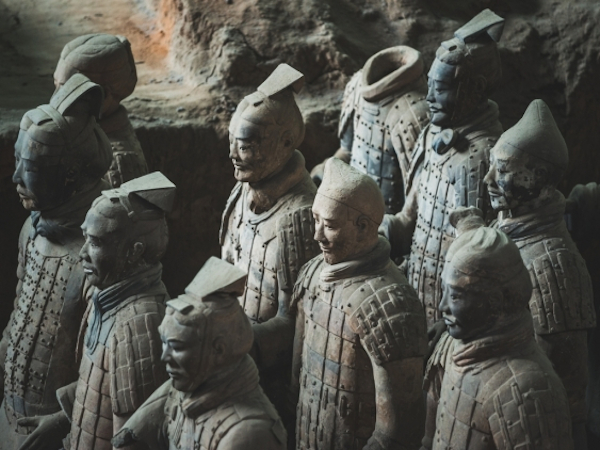Emerging technologies enabled the Emperor Qinshihuang’s Mausoleum Site Museum to undertake meticulous restoration tasks. Image: Shutterstock.
Dawn Lo, Victoria Ticha, Inside the digital transformation of China’s Terracotta Warriors, University of New South Wales, 30 July 2020
Digital transformation is not just about technology – it is about people and processes, says UNSW Business School’s Yenni Tim.
COVID-19 has illustrated that being digital is no longer a “nice to have” but a critical need for organisations to stay afloat, says Yenni Tim, Senior Lecturer in the School of Information Systems and Technology Management at UNSW Business School.
“It may be a silver lining of the coronavirus pandemic, as the value of digital transformation is being showcased and gaining wider recognition among employees,” adds Dr Tim.
But digital transformation is not just about choosing technology options and deciding what to do with them; it is also about people and processes, explains Dr Tim. So, regardless of the rapid pace of acceleration, organisations should be allowing long-term goals to drive change, adds Dr Tim.
These are some of the findings and insights discussed in Dr Tim’s recent co-authored paper, Back to the future: Actualising technology affordances to transform Emperor Qin’s terracotta warriors Museum, which sheds light on three key considerations for businesses embarking on a journey of digital transformation.
Define your goals and involve your people
The Qin Museum in the city of Xi’an, China is one of the largest mausoleum museums in the world, covering the mausoleum of the first emperor of China, Qin Shi Huang, with a total area of 2 million square meters. The museum houses the Terracotta Army – a collection of terracotta sculptures depicting the armies of the first emperor of China.
In 2014, the Qin Museum famously initiated a digital transformation plan in response to the changing demands of customers in the digital age. The transformation initiative was a large-scale, disruptive initiative which focused on leveraging emerging technologies, including augmented reality (AR), Internet of Things (IoT), mobile technologies and social media, to satisfy modern expectations in an increasingly digital world.
But since their formation in the 18th century, museums have primarily been insulated from technological disruptions, and it wasn’t until the most recent decade that one of the most significant technology-related transformations of museums occurred.

For example, 3D imaging technologies allowed museum experts to create highly precise digital surrogates from the fragile and fragmented artifacts, to prevent damage to the original objects. This was particularly important for the Qin Museum, as the terracotta relics can crumble through exposure to air and light.
But, as with many traditional organisations, the museum did not have sufficient technological competency to do this at first. However, they did have a clear understanding of what they were trying to achieve, and in the end, were successful. This is because a clear goal helps align employees’ work and provides a perspective for everyone to understand their role in the process and where the technology sits within that, explains Dr Tim.
So, it is essential to ask, “what exactly is it that I am hoping to achieve through this process of digital transformation?”. “Examine the goals of the organisation’s core beliefs and culture very closely before deciding on what technology to use and how to use them,” adds Dr Tim.
Goals drive results, not technology
From the beginning, there was a clear goal: to help preserve one of the most significant archeological excavations of the 20th century. In doing so, the project successfully created a precedent of using modern medical technology to restore ancient artifacts.
“Ultimately, what the organisation envisions post-transformation should be the drive for the transformation, not the technology,” says Dr Tim.
“For example, when we look at the Terracotta Warriors Museum, all initiatives that were part of the transformation, be the facial recognition app that allows you to find your most local light warrior, or the VR and AR museum tool, are all meant to achieve one goal: to communicate the rich history of their cultural artifacts and provide more opportunities for audiences today to get to know the underground army that is guarding the first emperor of China,” she continues.
“The museum also did a great job in leveraging insiders for their digital transformation. Learning about best practices from external organisations is useful. Still, the software has a rich contextual understanding about what works and what doesn’t, and it’s highly valuable in the process to align the organisation’s core identity and culture with the new initiatives.”
Acknowledge stress
Digital transformation is inevitably a challenging process for most organisations, especially for pre-digital firms that have long-established models and procedures, as well as an organisational structure and capital that cannot be easily reconfigured.
The use of emerging technologies meant that museum professionals faced the challenge of needing to cultivate new capabilities in the process. The employees had to learn new skills to meet the demands of the increasingly sophisticated digital operations at the museum. Unfortunately, this resulted in some museum professionals being overwhelmed and intimidated by the complexities that arose during the process.
“Business leaders should recognise that change is never easy, but at the same time, business leaders should encourage everyone to view digital transformation as an opportunity – not as a threat,” says Dr Tim.
“It is not about having the old being swept away by the new. It is about empowerment and an exercise where everyone in the organisation plays a part in developing better ways to deliver the company’s core value propositions,” concludes Dr Tim.
For the full story, visit UNSW BusinessThink.

